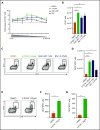Lysine-specific demethylase 1A restricts ex vivo propagation of human HSCs and is a target of UM171
- PMID: 32582923
- PMCID: PMC7645986
- DOI: 10.1182/blood.2020005827
Lysine-specific demethylase 1A restricts ex vivo propagation of human HSCs and is a target of UM171
Abstract
Culture conditions in which hematopoietic stem cells (HSCs) can be expanded for clinical benefit are highly sought after. Here, we report that inhibition of the epigenetic regulator lysine-specific histone demethylase 1A (LSD1) induces a rapid expansion of human cord blood-derived CD34+ cells and promotes in vitro propagation of long-term repopulating HSCs by preventing differentiation. The phenotype and molecular characteristics of cells treated with LSD1 inhibitors were highly similar to cells treated with UM171, an agent promoting expansion of HSCs through undefined mechanisms and currently being tested in clinical trials. Strikingly, we found that LSD1, as well as other members of the LSD1-containing chromatin remodeling complex CoREST, is rapidly polyubiquitinated and degraded upon UM171 treatment. CRISPR (clustered regularly interspaced short palindromic repeats)/Cas9 depletion of the CoREST core member, RCOR1, resulted in expansion of CD34+ cells similar to LSD1 inhibition and UM171. Taken together, LSD1 and CoREST restrict HSC expansion and are principal targets of UM171, forming a mechanistic basis for the HSC-promoting activity of UM171.
© 2020 by The American Society of Hematology.
Conflict of interest statement
Conflict-of-interest disclosure: The authors declare no competing financial interests.
Figures






Comment in
-
"Breaking down" the mechanisms of expansion.Blood. 2020 Nov 5;136(19):2095-2096. doi: 10.1182/blood.2020007600. Blood. 2020. PMID: 33152088 No abstract available.
Similar articles
-
Effects of Eupalinilide E and UM171, alone and in combination on cytokine stimulated ex-vivo expansion of human cord blood hematopoietic stem cells.Blood Cells Mol Dis. 2020 Sep;84:102457. doi: 10.1016/j.bcmd.2020.102457. Epub 2020 Jun 1. Blood Cells Mol Dis. 2020. PMID: 32604056 Free PMC article.
-
UM171 Preserves Epigenetic Marks that Are Reduced in Ex Vivo Culture of Human HSCs via Potentiation of the CLR3-KBTBD4 Complex.Cell Stem Cell. 2021 Jan 7;28(1):48-62.e6. doi: 10.1016/j.stem.2020.12.002. Cell Stem Cell. 2021. PMID: 33417871
-
UM171 promotes expansion of autologous peripheral blood hematopoietic stem cells from poorly mobilizing lymphoma patients.Int Immunopharmacol. 2020 Apr;81:106266. doi: 10.1016/j.intimp.2020.106266. Epub 2020 Feb 12. Int Immunopharmacol. 2020. PMID: 32062079
-
Small molecule regulation of normal and leukemic stem cells.Curr Opin Hematol. 2015 Jul;22(4):309-16. doi: 10.1097/MOH.0000000000000151. Curr Opin Hematol. 2015. PMID: 26049751 Review.
-
Ex vivo expansion of hematopoietic stem cells.Sci China Life Sci. 2015 Sep;58(9):839-53. doi: 10.1007/s11427-015-4895-3. Epub 2015 Aug 5. Sci China Life Sci. 2015. PMID: 26246379 Review.
Cited by
-
UM171 enhances fitness and engraftment of gene-modified hematopoietic stem cells from patients with sickle cell disease.Blood Adv. 2024 Nov 26;8(22):5885-5895. doi: 10.1182/bloodadvances.2024013932. Blood Adv. 2024. PMID: 39293082 Free PMC article.
-
Ex vivo hematopoietic stem cell expansion technologies: recent progress, applications, and open questions.Exp Hematol. 2024 Feb;130:104136. doi: 10.1016/j.exphem.2023.12.001. Epub 2023 Dec 9. Exp Hematol. 2024. PMID: 38072133 Free PMC article. Review.
-
Ex Vivo Expansion and Homing of Human Cord Blood Hematopoietic Stem Cells.Adv Exp Med Biol. 2023;1442:85-104. doi: 10.1007/978-981-99-7471-9_6. Adv Exp Med Biol. 2023. PMID: 38228960
-
LSD1 Inhibition Enhances the Immunogenicity of Mesenchymal Stromal Cells by Eliciting a dsRNA Stress Response.Cells. 2022 Jun 1;11(11):1816. doi: 10.3390/cells11111816. Cells. 2022. PMID: 35681511 Free PMC article.
-
The quest for the holy grail: overcoming challenges in expanding human hematopoietic stem cells for clinical use.Stem Cell Investig. 2023 Jul 11;10:15. doi: 10.21037/sci-2023-016. eCollection 2023. Stem Cell Investig. 2023. PMID: 37457748 Free PMC article. Review.
References
-
- Laughlin MJ, Barker J, Bambach B, et al. . Hematopoietic engraftment and survival in adult recipients of umbilical-cord blood from unrelated donors. N Engl J Med. 2001;344(24):1815-1822. - PubMed
-
- Baudet A, Karlsson C, Safaee Talkhoncheh M, Galeev R, Magnusson M, Larsson J. RNAi screen identifies MAPK14 as a druggable suppressor of human hematopoietic stem cell expansion. Blood. 2012;119(26):6255-6258. - PubMed
Publication types
MeSH terms
Substances
LinkOut - more resources
Full Text Sources
Other Literature Sources
Medical
Molecular Biology Databases
Research Materials

